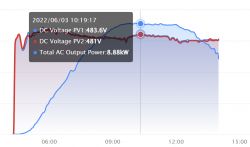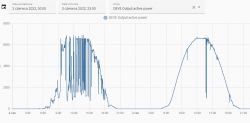It seems that when it is a cloudy day, the inverter cuts the power for short moments when the sun comes out from behind the clouds because on the module chains the voltage from the nominal Pmax 492V jumps to about 532V.

But in the case like today, when the whole day is sunny, the voltage does not reach the Pmax level, are the modules warmed up so much? Or maybe the inverter in the vicinity of the maximum power, to which it gradually comes, selects the operating point strangely?
The recorded highest is about 484V, ie about 10% below the voltage from yesterday.
Would he get anything more? Probably yes, but not much. On the next sunny day, I will unplug one string near the maximum power and check how much the inverter is able to squeeze out of half of the modules.

Roof angle 40 degrees, south-east direction.

But in the case like today, when the whole day is sunny, the voltage does not reach the Pmax level, are the modules warmed up so much? Or maybe the inverter in the vicinity of the maximum power, to which it gradually comes, selects the operating point strangely?
The recorded highest is about 484V, ie about 10% below the voltage from yesterday.
Would he get anything more? Probably yes, but not much. On the next sunny day, I will unplug one string near the maximum power and check how much the inverter is able to squeeze out of half of the modules.

Roof angle 40 degrees, south-east direction.



